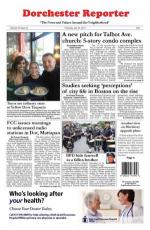March 17, 2011
 The Leahy-Holloran Community Center is a beehive of activity on nearly every day of the week — from a popular pre-school to yoga classes for adults. Photo by Gal Tziperman LotanThe squeals of delight from the roomful of children during school hours echoed through the Richard J. Murphy Elementary School in Dorchester.
The Leahy-Holloran Community Center is a beehive of activity on nearly every day of the week — from a popular pre-school to yoga classes for adults. Photo by Gal Tziperman LotanThe squeals of delight from the roomful of children during school hours echoed through the Richard J. Murphy Elementary School in Dorchester.
But they weren’t coming from a Murphy classroom. The children were all preschoolers attending the day-care program at the Leahy-Holloran Community Center, which is attached to the Murphy School.
The preschool program, which draws 72 children, is one of some 20 programs at the community center on Worrell Street, which in less than three years has become a showcase of success for the Boston Centers for Youth & Families (BCYF).
Leahy-Holloran is not the only community center to remake itself over the last several years and begin to offer the variety of programming for children and adults that Boston neighborhoods so desperately need.
Consider the Perkins Community Center, which is located inside the Joseph Lee Elementary School on Talbot Avenue. Last month, a long line of people began queuing up outside the center, waiting for it to open so they could attend a job fair that promised employment for neighborhood residents who might have a criminal record.
The Perkins partnered with an independent group called the Center for Church and Prison to put on the day-long event, which attracted more than 600 people, according to Troy Smith, program director at the Perkins.
“I’ve never seen our one Xerox machine do so much business – copying resumes, employment forms, letters, the whole range,” Smith said in a recent interview.
Consultants and city officials have struggled during the almost 40 years that community centers have been in existence to determine why one succeeds and another fails at their common goal of providing diverse programming – from arts to athletics.
A common factor that distinguishes the successful ones, according to Smith and Jill LaMonica, who heads the Leahy-Holloran Center, is the active presence of a community council that is totally dedicated to what is taking place inside their neighborhood facility.
The two Dorchester centers now boast vibrant councils that serve their neighborhoods, their members and directors spurred on by the grim findings of a 2004 study of BCYF management that found minimal programming being provided at many community centers, due, in part, to dysfunctional councils. Even though a single council overseeing one neighborhood community center is viewed by some as the model to ensure optimal programming, 20 of BCYF’s network of 38 centers are supervised by councils that have more than one facility to monitor.
One cause cited for the lack of programming in the past at the Leahy-Holloran was not that its council was divided but that it was inactive. (The center itself was long known as the Murphy Community Center, but was re-named in 2010 as a memorial to three local men: brothers Brian and Michael Leahy and Joe Holloran, all widely-admired community activists.) Three years ago, the head of Leahy-Holloran’s eight-member council hadn’t attended a meeting in years; another was dead; and still another was very ill; but all were considered members. The council was coasting with minimal fundraising while maintaining the center’s successful preschool and a few “gym and swim” programs that had been in place since the 1970s, according to residents.
“If you’re not going to control the councils, you’re not going to control what happens in the centers,” said City Councillor Maureen Feeney, who has been working with community members and BCYF employees to help improve the centers. “You can see why the idea of community centers was so widely popular, because the community had control over its own sites. But in reality, I don’t know if that concept can continue. I really don’t.”
In 2008, a small group of mothers came to Jill LaMonica, now the center’s administrative coordinator, and asked what they could do to bolster programming. The neighborhood’s demographics had changed in the 30 years the center had been in operation – more young families, more people of color – but programming at the Leahy-Holloran was stagnant.
At the next open council elections, about a third of the center’s 1,000 members voted. The council now has 25 members, only one of whom had a seat on the old council. Now members can pay to participate in programs that offer much diversity: book clubs, yoga, Italian cooking classes, and swimming lessons, to name a few – so many, in fact, that LaMonica said one of her goals is to streamline programs to a more manageable number.
A similar situation exists at the Perkins Center. Eight years ago, the center lost its own council when it was placed in the Dorchester “cluster,” which had oversight responsibility for three other centers, the Marshall, Cleveland, and Holland. Smith decided to leave the Perkins as well, taking a similar supervisory position at the BCYF’s center in West Roxbury.
Three years ago, he returned to the Perkins, and the center reverted to its earlier setup: oversight by a single council whose members all reside in the Franklin Field neighborhood.
The move has worked wonders for the programming now being offered at the Perkins for the one-square-mile Dorchester neighborhood that it serves, said council president Eric Bradshaw, a Boston Police officer. The center not only offers activities to benefit local youth, but it also provides the largely Haitian community with adult literacy/education programs and an option to work on getting their GEDs.



